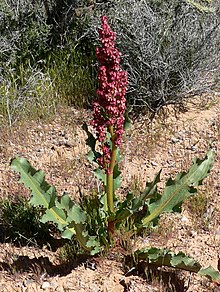Rumex hymenosepalus
| Rumex hymenosepalus | |
|---|---|

| |
| Scientific classification | |
| Kingdom: | Plantae |
| Clade: | Tracheophytes |
| Clade: | Angiosperms |
| Clade: | Eudicots |
| Order: | Caryophyllales |
| Family: | Polygonaceae |
| Genus: | Rumex |
| Species: | R. hymenosepalus
|
| Binomial name | |
| Rumex hymenosepalus | |
| Synonyms[1] | |
|
Rumex arizonicus | |
Rumex hymenosepalus, commonly known as canaigre, canaigre dock, ganagra, wild rhubarb, Arizona dock, and tanner's dock,[2] is a perennial flowering plant which is native to the North American deserts in the southwestern United States and northern Mexico. It is a common food plant of the ruddy copper larvae.[3]
Uses
[edit]It has been cultivated in the southwestern United States for the roots, a good source of tannin, which is used in leather tanning. It also yields a warm, medium brown dye.[4] The leaves and leaf stalks are considered edible when young, the older leaf stalks cooked and eaten like rhubarb, which is in the same plant family.[5]
Taxonomy
[edit]Rumex hymenosepalus was first described by American botanist John Torrey in the Report on the United States and Mexican Boundary in 1859.[6]
- Synonyms
- Rumex arizonicus Britton
- Rumex salinus A. Nelson
- Rumex hymenosepalus var. salinus (A. Nelson) Rech.
- Rumex saxei nom. nudum. UNAM
References
[edit]- ^ Rumex hymenosepalus. Flora of North America.
- ^ "Rumex hymenosepalus". Germplasm Resources Information Network. Agricultural Research Service, United States Department of Agriculture. Retrieved 21 December 2017.
- ^ Warren, Andrew. "Butterflies of Oregon Their Taxonomy, Distribution, and Biology". Lepidoptera of North America. 6.
- ^ Canaigre. drugs.com
- ^ American Indian Cooking: Recipes from the Southwest, Carolyn Niethammer
- ^ Torrey, J. 1859. Report on the United States and Mexican Boundary. Botany 2(1): 177–178. 1859.1
External links
[edit] Media related to Rumex hymenosepalus at Wikimedia Commons
Media related to Rumex hymenosepalus at Wikimedia Commons- "Rumex hymenosepalus". Plants for a Future.
- "Rumex hymenosepalus". Calflora. Berkeley, California: The Calflora Database.
- Rumex hymenosepalus in the CalPhotos photo database, University of California, Berkeley
- The Jepson Manual eFlora (TJM2) treatment of Rumex hymenosepalus
- NatureServe secure species
- Rumex
- Flora of the Southwestern United States
- Flora of the South-Central United States
- Flora of Baja California
- Flora of California
- Flora of Chihuahua (state)
- Flora of Colorado
- Flora of the California desert regions
- Flora of the Great Basin
- Natural history of the California chaparral and woodlands
- Natural history of the Mojave Desert
- Natural history of the Peninsular Ranges
- Natural history of the Transverse Ranges
- Plants used in traditional Native American medicine
- Taxa named by John Torrey
- Polygonaceae stubs

